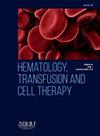当创新遇到患者血液管理--一种看待出血的新方法。
IF 1.8
Q3 HEMATOLOGY
引用次数: 0
摘要
创新的第一步是发现一个真正相关的问题,并系统地加以解决,以提供一个成熟可行的解决方案。颠覆性创新是一个技术、产品或服务被更好的创新解决方案改变或取代的过程。这种优越性必须被用户认为更容易获得、更简单或更方便。患者血液管理(PBM)是指及时应用循证医学和外科概念,旨在维持血红蛋白浓度、优化止血和减少失血,从而改善患者预后,即旨在改变患者护理,协助医护人员治疗和治愈疾病以及降低风险。因此,PBM 的创新是一个有待开发的新领域。病人的血液管理和手术准备是一项巨大的挑战,它有助于最大限度地减少贫血,控制住院期间的失血量,确保病人在充分的临床条件下出院。直到 2016 年,对于术中出血或止血的严重程度还没有标准的定义或分类。PBM 计划的制定与出血量表(如有效的术中出血量表 (VIBe) 量表)的制定相结合,代表了一种平衡围术期失血的新解决方案,更重要的是,它促成了一种关键的文化变革,有助于外科医生在整个病例中沟通预期的止血需求,从而提高效率,获得更好的治疗效果。本文章由计算机程序翻译,如有差异,请以英文原文为准。
When innovation meets patient blood management – a new way to see bleeding
The first step in innovation is to identify a problem of real relevance and systematically address it to deliver a sophisticated and viable solution. Disruptive innovation is a process where technology, products, or services are transformed or replaced by a better innovative solution. This superiority must be perceived by users as being more accessible, simple, or convenient. Patient Blood Management (PBM) suggests the notion of the timely application of evidence-based medical and surgical concepts designed to maintain hemoglobin concentration, optimize hemostasis and minimize blood loss thus improving patient outcomes, that is, they are aimed at changing patient care, assisting healthcare professionals in disease treatment and cure as well as risk reduction. Thus, innovation in PBM is a new frontier to be pursued. The management of patient's blood and preparation for surgical procedures is an enormous challenge that helps minimize anemia and control blood loss during hospitalization, ensuring they are discharged in adequate clinical conditions. Until 2016, there was no standard definition or classification for the severity of intraoperative bleeding or hemostasis. The development of a PBM program when combined to the development of a bleeding scale such as the validated Intraoperative Bleeding (VIBe) Scale, represents a new solution that balances perioperative blood loss and more importantly, enables a critical cultural change which can be useful to help surgeons communicate anticipated hemostatic needs throughout a case and therefore enhance efficiency leading to better outcomes.
求助全文
通过发布文献求助,成功后即可免费获取论文全文。
去求助
来源期刊

Hematology, Transfusion and Cell Therapy
Multiple-
CiteScore
2.40
自引率
4.80%
发文量
1419
审稿时长
30 weeks
 求助内容:
求助内容: 应助结果提醒方式:
应助结果提醒方式:


